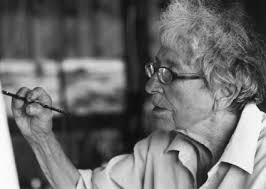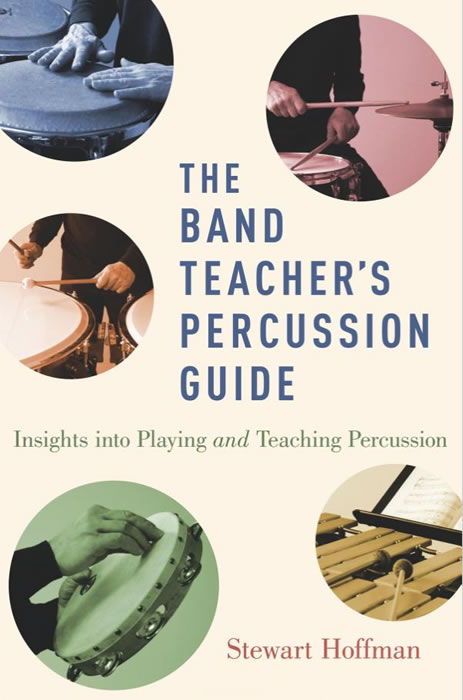McCarthy’s Spark
(Profile of artist Doris McCarthy)
Homemaker’s Magazine, December 2000
By Stewart Hoffman

Artist Doris McCarthy at work.
She claims she’s “no hell” as a skater, but as the final credits roll for the documentary, Doris McCarthy: Heart of a Painter, the artist executes a series of graceful turns across a frozen pond, then ends her routine with a flourish; arms spread like wings, her body and left leg drawn parallel to the ice, she looks like a plane gliding in for a landing.
Doris McCarthy made the film 18 years ago, when she was 72. Today, at 90, she says her skills remain undiminished. The attention-grabbing finale remains “a show-off thing I do at the end of my routine.”
McCarthy’s life is one showstopper after another. The view of Lake Ontario from “Fool’s Paradise”, her five-acre property on the Scarborough Bluffs, on the outskirts of Toronto, is nothing short of spectacular. To McCarthy, a diminutive woman with an energetic handshake and blazing blue eyes, her home is an enormous source of pride, even more, perhaps, than the countless watercolours and oil paintings that have made her one of the country¹s most renowned artists. She takes the short drive from here to the skating rink three mornings a week. “I skate for about an hour,” she says. “But I skate hard. I don’t sit down to rest. I haven’t time.”
No kidding. In a two-week space last September, for example, McCarthy judged art shows in both Vancouver and Toronto; flew, by helicopter, to a lodge high in the Selkirk Mountains on a painting expedition; and lectured at the opening of a retrospective of her watercolours at the Tom Thompson Memorial Art Gallery in Owen Sound, Ont.
From what magical spring does she summon the energy? “From motivation,” she shoots back promptly. “Because I want to do things. If I ever wake up in the morning and there’s nothing on my program, I’m limp. But if there’s something interesting, I have the energy to get up and get going.”
She attributes her zest for life to the creativity of her work, work which has in no way become routine over the years. She’s started up her own virtual art gallery (www.dorismccarthy.com), and her pioneer-like temperament has taken her around the world, from the Rockies to the Gaspé to the ancient temples of Angkor Wat in Cambodia. Her beloved Arctic has provided the inspiration for dozens of magical landscapes. She¹s looking ahead to a trip in the spring to either Tunisia or Morocco. “I haven’t painted all the places I want to paint. I haven’t found out all the things I need to know about being a painter.”
Not that her curiosity is limited to painting. She took her first literature course at the University of Toronto in 1974. Fifteen years later, she was on the dais at U of T’s convocation ceremonies, accepting an Honours BA diploma. An official at the time observed that, at 79, she was the first person to receive an undergrad diploma after being invested as a Member of the Order of Canada.
“It’s very hard to separate Doris’s art from her well-being,” says longtime friend Lynne Atkinson. “Doris today is the same as she has been for decades, going out and searching for that wonderful spot which she can transform into a painting. But while her art is critical in keeping her going and keeping her happy and lively, so is her intellectual curiosity. We might not all be able to go to the top of Revelstoke Mountain in a helicopter and paint, but we can all take courses at a university close by.”
And though McCarthy emphasizes the importance a positive outlook has to overall health, the quest for well-being does not end there. “Cherish health, seek truth, know God, serve others,” she says with conviction. “And cherish health is first. You can’t do any of the others if you don’t look after your own body.” With her customary determination, the once nicotine-addicted McCarthy quit smoking cold turkey on New Year’s Day, 1950. She drinks “reasonably sensibly” and, although she enjoys good food, it’s not the most important thing. “I enjoy not being fat,” she says emphatically. “When I was 16 I weighed 150 pounds and I hated myself. I worked very hard to get rid of it. I learned to say no to myself.”
In truth, Doris McCarthy has never been what you’d call a couch potato. She canoed as a young girl, and as an adult shunned elevators in favour of stairs for the 40 years she taught art at Toronto’s Central Technical School. “And once I bought this place,” she adds, referring to the property she purchased in 1939, “there was plenty of exercise.” And she doesn’t mean puttering around the garden. A 1946 photo in Volume One of her memoirs, A Fool in Paradise: An Artist’s Early Life (McFarlane, Walter & Ross, 1990), shows McCarthy high atop the new garage addition, hammering down the roof.
Her exercise routine these days is more down to earth – literally. She starts her day flat out on the floor doing leg lifts – 36 of them – balancing eight-pound weights on each ankle. At the same time, she’s pulling at a chest exerciser for her upper body. “I’ve got osteoporosis,” she explains. “I want to shake it or retard it or reverse it.”
And if you think that might be cause for concern on the skating rink, it’s not. Sure, she falls occasionally but doesn’t worry about it. She even broke her wrist once. But rather than hanging up her skates for good, she responded by learning how to fall. Says Atkinson: “Anybody who operates out of fear is going to find their world closing down. Doris isn’t going to operate out of fear.”
But ask McCarthy from where she draws the greatest source of strength and she’s likely to say it stems from her deep sense of spirituality. “I live in the presence of God,” she says. “Consciously. I have taken to saying grace before meals because I want that moment of awareness, of being thankful for how good life is.” It allows her to put life into perspective, to strike a balance, to differentiate the important from the unimportant.
And if you can manage that, she says, life becomes relatively stress-free. “You live relaxed. You live in joy.” She pauses, reflecting for a moment. “It’s quite possible to live in joy.”
(Profile of artist Doris McCarthy)


